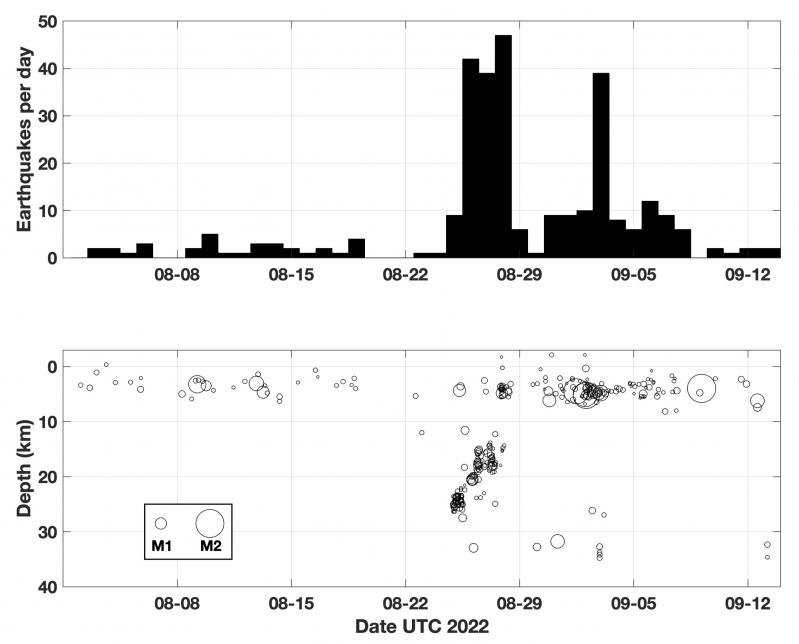
Earthquakes located under Trident volcano, Alaska, from August 1 to September 13, 2022. The top panel shows earthquakes per day, and the bottom panel shows earthquake depths through time. A swarm of relatively deep earthquakes started on August 24, with earthquakes getting more shallow over time. The rate of events per day remained elevated through the first week of September and is almost back to normal as of September 13. The size of the circles in the lower panel reflects the magnitude of the earthquakes as shown in the legend.
Volcano(es): Trident
Photographer: Haney, Matthew
URL: avo.alaska.edu/image/view/193632
Credit: Image courtesy of AVO/USGS.
Use Restriction: Please cite the photographer and the Alaska Volcano Observatory / U.S. Geological Survey when using this image.
Full Resolution.
Trident unrest 2022
On August 24, 2022, an earthquake swarm began beneath Trident volcano in the Katmai area. The first earthquakes were at deep levels in the crust, around 16 miles below sea level, but progressed upward to about 3 miles beneath the surface over the next five days. Dozens of magnitude 0.7 to 1.9 earthquakes happened each day over this time period, but the rate of earthquakes dropped off somewhat after the 28th. There were also a few periods of volcanic tremor and low-frequency earthquakes.
On September 14, 2022, AVO released an Information Statement about the earthquake activity at Trident, stating that no other signs of unrest had been observed and that the seismic activity was likely caused by movement of magma or magmatic fluids.
After the earthquakes continued into the next month, AVO raised the alert levels to YELLOW/ADVISORY on September 29.
On October 19, 2022, citing that the rate of earthquakes had dropped and seismic tremor had not observed since September 30, 2022, AVO lowered the Aviation Color Code to GREEN and the Volcano Alert Level to NORMAL.
On November 20, there was a magnitude 4.6 quake – this was far larger than most of the quakes in the area.
In late 2022 into January 2023, the rate of earthquakes began to pick up again. There were also more earthquakes occurring under Mount Katmai to the east, and under Martin and Mageik volcanoes to the west, though the largest number of earthquakes continued to be beneath Trident, as well as periods of tremor.
On January 11, 2023, AVO released an information statement for Katmai, Trident, Martin, and Mageik volcanoes, noting this more elevated activity.
On February 22, 2023, AVO again raised the Aviation Color Code and Volcano Alert Level at Trident to YELLOW/WATCH, stating that earthquakes were continuing to occurr at about 10 per day. The notice also stated that because of the tremor observed beneath Trident and the initial swarm there, the unrest in the broader Katmai region was likely, though not certain, because of magma or magmatic fluid movement beneath Trident.
In May 2023, AVO began detecting a marked increase in low-frequency earthquakes—in addition to regular earthquakes—at shallow and deep levels in the region between Trident and Novarupta, which lies 3 miles to the northwest. These types of earthquakes often indicate the movement of magma or magmatic fluids within the Earth’s crust. The deep low-frequency earthquakes were often accompanied by longer-duration bursts of continuous tremor, indicating deep fluid movement.
In June, satellite radar data taken in newly snow-free conditions was compared to data taken in the fall, which showed that Trident Volcano had inflated slightly, with the ground uplifted by about 2 inches, especially on the southern flank.
On July 25, 2023, AVO released another Information Statement about this activity, noting that earthquakes also continued to occur around Mount Katmai and Martin and Mageik volcanoes, but AVO continued to believe this was likely a secondary effect of magma/magmatic fluid intrusion beneath Trident.
After July, earthquake activity remained elevated, and deep low-frequency earthquakes and periods of tremor continued. In September AVO noted that there was an increase in the rate of earthquakes very deep in the crust (greater than 9 miles down), as well as some minor additional ground deformation.
Beginning in early October rates of earthquake activity declined somewhat, especially deeper earthquakes. AVO noted that this might indicate a decline in magma/magmatic fluid activity beneath Trident.
Seismicity remained slightly elevated in December.
In the first week of January, AVO noted that while earthquakes were still occurring, their rate was now approaching the typical or "background" state for the Katmai area. Due to this, AVO lowered the alert levels back to GREEN/NORMAL on January 10, 2024.